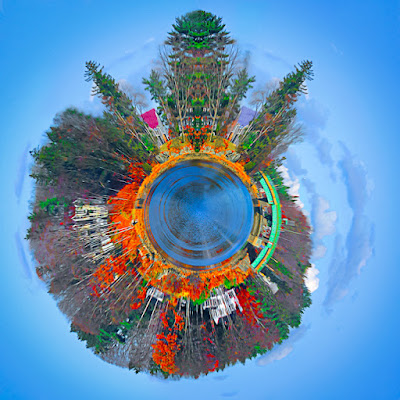 It's the holiday season, the year is winding down, jobs are
getting a little scarce, so it must be time to play. To go for the artsy stuff, something that
might end up on a greeting card or some other form that can be done on
spec. It might even bring in a buck or
two and that would be gravy. Doing work
aimed at the greeting card industry is kind of a seasonal crapshoot. Too early and it won't be looked at. Too late, same thing. Too cute (they can hardly ever be too cute)
and it won't be picked up because it's been done to death. Too serious is probably worse than too
cute. Cards that say 'sorry you died'
walk a very fine line. Note cards, with
photographs on the cover, have to convey what's written on the inside without
giving away the sentiment. Today's image would fall under the heading of whimsical. It started life as a photograph. Actually, a five shot panorama, and ended up
having something to do with a lake house.
It could be an invitation, a "new house" announcement, a
cheery note signaling the start of the new season for the lake community, or
other lighthearted information. It
probably wouldn't be the best card to say the house burned down or the EPA just
shutdown swimming privileges because they found out someone did nuclear testing
on the shore back in the forties. You
get the idea. You have to set the right
tone for the target audience. I'll leave
it up to you to figure out what you might use a card with today's image on the
front. What we'll do is discuss how the
image was made. To find out what alchemy
was conjured to produce today's image, hit the "Read More".
It's the holiday season, the year is winding down, jobs are
getting a little scarce, so it must be time to play. To go for the artsy stuff, something that
might end up on a greeting card or some other form that can be done on
spec. It might even bring in a buck or
two and that would be gravy. Doing work
aimed at the greeting card industry is kind of a seasonal crapshoot. Too early and it won't be looked at. Too late, same thing. Too cute (they can hardly ever be too cute)
and it won't be picked up because it's been done to death. Too serious is probably worse than too
cute. Cards that say 'sorry you died'
walk a very fine line. Note cards, with
photographs on the cover, have to convey what's written on the inside without
giving away the sentiment. Today's image would fall under the heading of whimsical. It started life as a photograph. Actually, a five shot panorama, and ended up
having something to do with a lake house.
It could be an invitation, a "new house" announcement, a
cheery note signaling the start of the new season for the lake community, or
other lighthearted information. It
probably wouldn't be the best card to say the house burned down or the EPA just
shutdown swimming privileges because they found out someone did nuclear testing
on the shore back in the forties. You
get the idea. You have to set the right
tone for the target audience. I'll leave
it up to you to figure out what you might use a card with today's image on the
front. What we'll do is discuss how the
image was made. To find out what alchemy
was conjured to produce today's image, hit the "Read More".
There are two ways to make an image similar to today's. Outside in and inside out. It all depends on if you flip the original
panorama or not. If you leave the pano
right side up, using Adobe Photoshop CS5's (and earlier version's) Polar
Coordinates Filter (Filter/Distort/Polar Coordinates) set to Rectangular To
Polar, you'll get a view as if you're in a hole looking up at the scene. To you flip the pano vertically (Image/Image
Rotation/Flip Canvas Vertical) and then apply the same Polar Coordinates Filter
you'll wind up with a view as though you're on a high point seeing a 360 degree
scan looking straight down. Sort of like
seeing a shot of a full moon with lots of detail on the edge.
When a panorama is used to make this type of polar
projection image the scene will start out as a rectangle. The Canvas should be expanded (Image/Canvas
Size) it create a square format. The
scene can then be brought into a circular form using Free Transform (Edit/Free
Transform) and pulling the center handles up and down.
What you end with in either case is some sort of circle and
from the outer edge of the circle to the square edges of the "paper"
you'll have what looks like zoom lines.
It's a pretty (if you ask me) unfinished look. In order to give the appearance of sky in
today's image the "zoomy" lines were masked out. A Layer Mask was added and the Elliptical
Marquee Tool (M) used with the Shift Key held down (to constrain the shape to a
circle) to define the edge of the circle.
The Layer Mask was then filled with Black, hiding the zoom lines.
A blank Layer was added under the Masked Layer (Ctrl - Add
New Layer icon). The Eyedropper Tool (I)
(eye) was then used to sample the color of the sky. This set the Foreground Color to the same
color as the sky in the image. The
Background Color was then set to another shade of blue several shades darker
than the foreground. Using the Gradient
Tool (G) set to Radial Gradient the blank Layer was filled using an inside to
outside stroke holding down the mouse button.
A couple attempts were needed to correctly position the inner blue
shade.
Typical color enhancement to the "ground Layer"
was done using individual (Red, Yellow, Green, Cyan, Blue, and Magenta)
Hue/Saturation Adjustment Layers.





0 comments:
Post a Comment